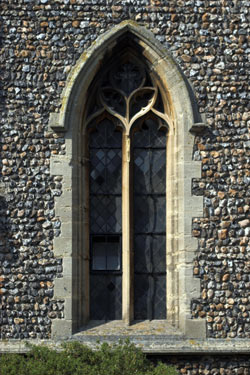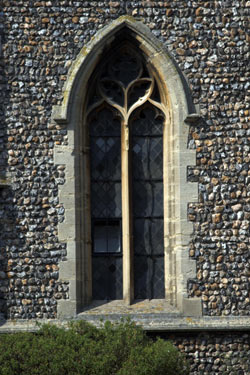Sigma 100-300mm f/4 EX DG
Here is a lens from Sigma that fits into the medium to long telephoto range and is a step up from the average 70-300mm models. It sports a constant aperture of f/4 and Sigma’s HSM autofocus motor. We take a look at how it performs.
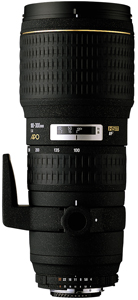 Specification
Specification
- Focal length 100-300mm
- Max aperture f/4
- Min aperture f/32
- Construction 16/14 elements/groups
- Closest focus 1.8m
- Reproduction ratio 1:5
- Filter size 82mm
- Dimensions 92.4x227mm
- Weight 1.44kg
- Price (SRP) £899
Build and handling
The lens is one of Sigma’s EX range and is finished in their matt black with white engraving and a little gold for the logos. This finish has proved to be quite hard wearing and is certainly quite smart in it’s looks. There is an AF/MF switch in the usual place and the lens comes supplied with a tripod collar that is Sigma’s quick release design that I have expounded on before in these pages. Next comes a 35mm wide zoom ring, three quarters of which has a comfortable ribbed rubber finish. It is marked at the 100, 135, 200, 250 and 300mm points and is torqued very slightly on the stiff side, giving the impression that it is built to last.
A neat, flush, distance window separates this from the larger (75mm) manual focus ring which is again covered for three quarters of its length with a matching rubber ribbing.
Autofocus is achieved with HSM, Sigma’s hypersonic system that is both quick and virtually silent in operation. The lens stays the same length throughout both focussing and zooming, and without the front element rotating, making life for filter users easy with the 82mm filter thread. Also supplied with the lens is a front lens hood that is more or less a bucket shape with the slight exception of a small cut-out to stop vignetting at the wider setting. The hood is a nice, snap bayonet, fitting that stays in place during use.
The lens is also compatible with Sigma’s EX Teleconverters and retains autofocus when used with the 1.4X version.
Optical quality
As could be expected of a modern zoom lens design, this one is fairly well put together. Even the mathematically challenged can see that the zoom ratio comes in at 3:1 and this is the accepted limit where compromises in design start to raise problems. Things like distortion are well controlled and measured figures of –0.1% (barrel) at the short end and 0.45% (pincushion) at the full stretch of the lens are negligible and cannot be seen with the naked eye.
The new digital coating Sigma have applied to all of their lenses, to cut out light reflected back from digital sensors bouncing around inside the lens, has had the added benefit of improving contrast and the same is true of this optic. Resolution is pleasing and the performance in this department is very close across the frame with very little drop-off towards the edges. A bonus for users of full frame equipment.
The one area where there is a slight disappointment is in the control of Chromatic Aberrations (CA). There is no evidence anywhere in the range at the centre of the frame; however, at the longer focal length the anomaly does start to creep in at the very edges. Most of the time, and under a lot of circumstances, it would not be noticed, but it is there.
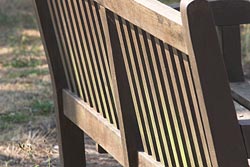 |  With the lens set at 300mm on a tripod and the 20D camera set to aperture priority, playing around with the aperture settings can either isolate a part of the subject or include most of it in focus. F/4 and f/16 were used on these two shots at ISO100 |
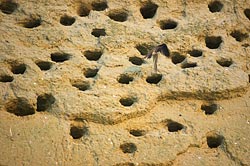 | 300mm is a good length for some wildlife work, as seen here trying to catch Sand martins flying in and out of their burrows. As an f/4 lens, it will retain autofocus when used with Sigma’s dedicated 1.4x converter. |
Click on each comparision photo below to view full size versions
Below is our lens test data. To find out how to use these graphs look at this article: How we test lenses
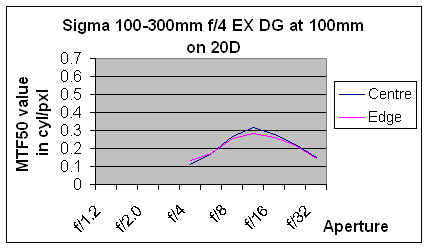
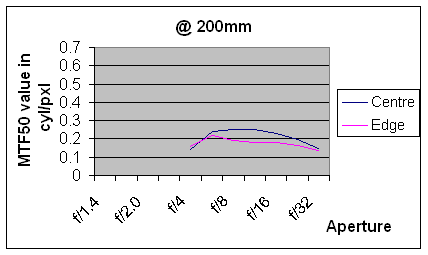
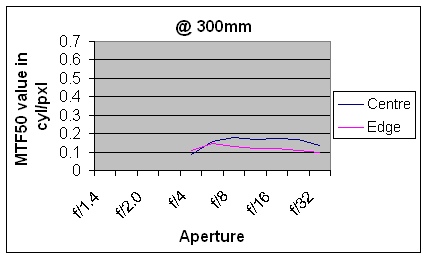
Verdict
As a step up from the run of the mill >300mm zooms this lens is certainly worth considering. The constant aperture and faster, quieter autofocusing make all the difference, ably helped by a constant length and internal focus mechanism to make handling a joy. Four SLD glass elements in the construction help to make a nice improvement to the output quality too.
In summary, the positive points of the Sigma 100-300mm f/4 EX DG are:
![]() Constant aperture and length
Constant aperture and length
![]() Fast, silent autofocus
Fast, silent autofocus
![]() Good contrast and resolution
Good contrast and resolution
The negative points are:
![]() Bigger size and weight than the lower group
Bigger size and weight than the lower group
![]() Some CA around the edges at the long end.
Some CA around the edges at the long end.
Check the latest price of the Sigma 100-300mm f/4 EX DG here
Discuss this lens and other related lens subjects here
Test by Ian Andrews www.wildaboutkent.com
Add your message
Please login here or if you've not registered, you can register here. Registering is safe, quick and free.
photodo Stats
428 MTF tests
74 in-depth photodo reviews
100+ users join each day
Help the lens community by reviewing or rating a lens today via our lens search
Latest Lens Reviews
- Chinon 28mm f/2.8 Vintage Lens Review
- Canon EF 70-200mm f/4L IS II USM Lens Review
- Samyang AF 85mm f/1.4 EF Review
- Sigma 70mm f/2.8 DG Macro Art Review
- Samyang AF 24mm f/2.8 FE Review
- Meike 50mm f/1.7 Review
- Tamron 70-210mm f/4 Di VC USD Review
- Lensbaby Burnside 35mm f/2.8 Review
- Asahi Super Takumar 50mm f/1.4 Review
- Asahi Super-Multi-Coated Takumar 135mm f/3.5 Review


